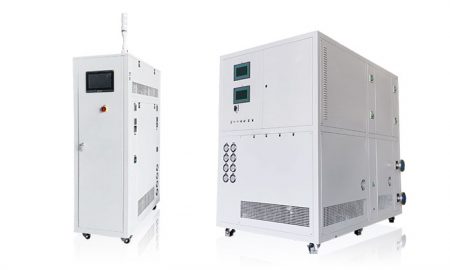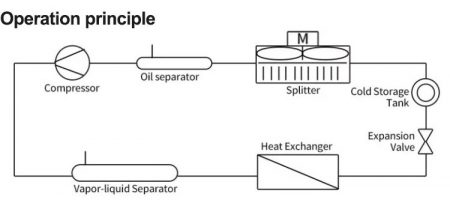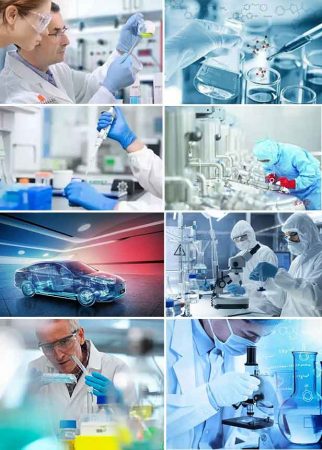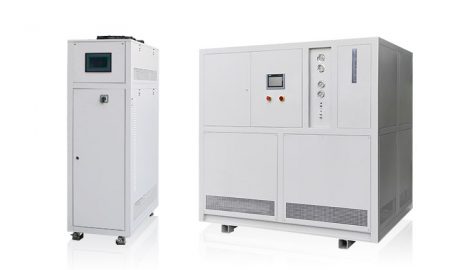Chillers
1. What are industrial chillers?
A chiller is a type of refrigeration equipment that is usually used in industrial production lines, commercial buildings, medical facilities, hotels, etc. to provide cooling water for these places. Chillers work by absorbing indoor or outdoor heat and transferring the heat to cooling water or air through processes such as compression, condensation, and evaporation to keep the temperature of the equipment or space stable.
Chillers are usually composed of compressors, condensers, evaporators and controllers. The compressor compresses the low-temperature and low-pressure gas into high-temperature and high-pressure gas, and the condenser releases the heat of the high-temperature and high-pressure gas by contacting with cooling water or air, and the temperature of the cooling water or air increases. The evaporator absorbs the heat of the low-temperature and low-pressure gas by contacting with the cooling water, and the temperature of the cooling water decreases. The controller controls the operation of the entire system to ensure temperature stability and safety.
Chillers for sale
 Precision Chillers / Small Chillers (Custom Designs)
Precision Chillers / Small Chillers (Custom Designs)
The chiller can be widely used in various industries and laboratories, and supports customized design.
| Temperature range | -18°C ~ +30°C | +5°C ~ +35°C series |
| Cooling Capacity | 0.35 ~ 0.9kW | 1.8 ~ 50kW |

Recirculating Chillers (Custom Designs)
Our recirculating chiller adopts low-temperature refrigeration technology, the temperature is as low as -120℃, and various accessories are customizable.
| Temperature range | -25°C ~ +30°C series | -45°C ~ +30°C series | -60°C ~ -20°C series | -80°C ~ -20°C series | -120°C ~ -70°C series |
| Cooling Capacity | 0.8 ~ 30kW | 0.75 ~ 12kW | 0.4 ~ 6kW | 0.2 ~ 6kW | 0.3 ~ 5kW |

Low Temperature Chillers (Custom Designs)
We specialize in the production of low-temperature chillers with a temperature control range as low as -150°C, which can meet the refrigeration needs of different industries.
| Temperature range | -25°C ~ -5°C series | -45°C ~ -10°C series | -60°C ~ -10°C series | -80°C ~ -30°C series | -110°C ~ -50°C series | -150°C ~ -110°C series |
| Cooling Capacity | 12 ~ 360kW | 6 ~ 180kW | 6 ~ 180kW | 4 ~ 180kW | 2 ~ 120kW | 2.5 ~ 11kW |
Special chillers for sale
 Chillers for Automotive Battery Test (Custom Designs)
Chillers for Automotive Battery Test (Custom Designs)
Temperature simulation for vehicle quality test: battery life test, fuel injector/motor test bench, airbag test, component test bench, etc.
| Temperature range | -25°C ~ +100°C | -40°C ~ +100°C | 0°C ~ +100°C | -40°C ~ +135°C |
| Cooling Capacity | 2.8 ~ 38kW | 1.2 ~ 60kW | 1.8 ~ 60kW | 4 ~ 60kW |
Temperature / Pressure / Flow can be independently controlled.
1&2: one machine for two groups control.
| Temperature range | -40 ~ +100℃ 1&2 | 0 ~ +100℃ 1&2 |
| Cooling Capacity | 1.8kW*2 ~ 60kW*2 | 1.8kW*2 ~ 60kW*2 |
Temperature remains constant, pressure / flow can be independently controlled.
1&3: one machine for three groups control.
1&6: one machine for six groups control.
| Temperature range | -40 ~ +100℃ 1&2 | -40 ~ +100℃ 1&3 | -40 ~ +100℃ 1&6 | -20 ~ +100℃ 1&6 | 0 ~ +100℃ 1&2 | 0 ~ +100℃ 1&3 | 0 ~ +100℃ 1&6 |
| Cooling Capacity | 2.5 ~ 60kW | 4 ~ 60kW | 10 ~ 60kW | 10 ~ 60kW | 7 ~ 60kW | 11 ~ 60kW | 18 ~ 60kW |

Chillers for Semiconductor (TES series) (Custom Designs)
Suitable for precise temperature control of electronic components. In the manufacture of semiconductor electronic components for harsh environments, the IC packaging assembly and engineering and production testing phases include electronic thermal testing and other environmental testing simulations.
| Temperature range | -45°C ~ +250°C series | -85°C ~ +200°C series | -60°C ~ +200°C series |
| Cooling Capacity | 0.3 ~ 25kW | 0.25 ~ 25kW | 3 ~ 60kW |

Chillers for Semiconductor (LTS series) (Custom Designs)
Suitable for precise temperature control of electronic components. In the manufacture of semiconductor electronic components for harsh environments, the IC packaging assembly and engineering and production testing phases include electronic thermal testing and other environmental testing simulations.
| Temperature range | -20°C ~ +80°C series | -45°C ~ +80°C series | -60°C ~ +80°C series | -80°C ~ +80°C series |
| Flow Control | 7 ~ 45 L/min | 7 ~ 45 L/min | 7 ~ 45 L/min | 7 ~ 45 L/min |

Chillers for Energy Storage(Custom Designs)
Liquid Cooling Solutions For Battery Energy Storage Systems
| Temperature range | -45°C ~ +55°C |
| Cooling Capacity | 45kW |

Screw Chillers (Custom Designs)
Low temperature screw chillers and room temperature screw chillers
| Temperature range | +5°C ~ +30°C | +5°C ~ +30°C | +5°C ~ +30°C | +5°C ~ +30°C | -25°C ~ +5°C | -25°C ~ +5°C |
| Cooling Capacity | 107 ~ 1027kW (Single Compressor) | 299 ~ 2134kW (Dual Compressor) | 98 ~ 934kW (Single Compressor) | 272 ~ 1940kW (Dual Compressor) | 48 ~ 467kW (Single Compressor) | 51 ~ 497kW (Single Compressor) |
Contact Us Now For A Custom Cooling Solution For Your Industry
2. How does an industrial chiller work?
The working principle of the chiller is to use the refrigerant to absorb and release heat in the process of compression and expansion to achieve the purpose of cooling.
The specific process is as follows:
Compressor suction: The compressor sucks the refrigerant gas from the evaporator and compresses it into a high-temperature and high-pressure gas.
Condenser exothermic: The high temperature and high pressure gas is cooled by the condenser to become a high pressure liquid and release heat.

3. What are industrial chillers used for?
Chillers are widely used in different industries, the following are some common application areas:
Manufacturing industry: Chillers are widely used in various manufacturing industries, such as automobile manufacturing, electronic manufacturing, plastic products, textiles, food processing, etc. During the manufacturing process, equipment and products need to be cooled to maintain stable temperature and humidity conditions.
Construction industry: Chillers are used in the construction industry for central air-conditioning systems, refrigeration and freezing equipment, and construction sites. The chiller supplies coolant through cooling water circulation, which is used to adjust the temperature and humidity inside the building to provide a comfortable indoor environment.
Medical industry: Chillers are mainly used in hospital operating rooms, laboratories and pharmaceutical production in the medical industry. Ensure the quality and safety of medical equipment and pharmaceuticals by cooling equipment and instruments to maintain a stable temperature and humidity.
Chemical industry: Chillers are widely used in the production process of the chemical industry, such as cooling of chemical reactions, cooling of equipment and provision of refrigerants. The chiller can provide a stable cooling effect to ensure the stability and safety of chemical production.
Electric power industry: Chillers are mainly used in the electric power industry for the cooling of power equipment and generator sets. By cooling the equipment, the operating temperature of the power equipment is kept within a safe range, and the operating efficiency and life of the equipment are improved.
Hotels, shopping malls and office buildings: Chillers are widely used in central air-conditioning systems in public places such as hotels, shopping malls and office buildings to provide a comfortable indoor environment.
In short, chillers are widely used in different industries, mainly for cooling and adjusting temperature and humidity, ensuring the normal operation of equipment and products, and providing a comfortable and safe environment.
4. Why water chiller is used?
Industrial chillers usually use water circulation to cool down, which has low operating costs and is easy to maintain. It only needs to regularly clean the dust on the dust cover and replace the circulating water every three months or so. The most important thing is that the water temperature can be adjusted, and the temperature can be set according to the cooling needs of various equipment. When installing the small chiller, you can directly carry the chiller and put it on the installation location. Medium or large chillers are equipped with Vientiane casters for easy mobile installation.
Advantages of chillers:
1. Simple structure and easy operation: few spare parts, clear control panel, easy repair and maintenance under the installation of internal configuration components. Moreover, it has low repair rate and long service life; the uniform circular motion is stable, and the noise and vibration are low during low-load operation.
2. Complete styles: The chiller has a wide range of cooling power and operating temperature to choose from, and it is very convenient for single-machine temperature control in various industries.
3. Long service life: The design of the evaporator and condenser is very reasonable, and it is placed above the compressor. During the entire operation process, most of the lubrication will always stay in the compressor, which can effectively ensure the good lubrication of the compressor.
4. Stable operation: It adopts a world-renowned fully-sealed compressor, which not only has the advantages of high efficiency, low noise, and small vibration, but also is equipped with multiple protection devices, which can effectively save energy, and an environmentally friendly refrigerant compressor can be used according to customer requirements.

5. Industrial chiller operation
First of all, the preparation work before starting
1. Check whether the power supply of the unit is properly connected.
2. Turn on the water in the system first, and then turn on the chiller.
3. Check whether there are abnormalities around the unit.
4. The water tank and condenser of the chiller must be filled with water, and do not run without water.
5. Check whether the chilled water valve is open, whether the water tank is in standby state, and whether the cooling pump is running without failure.
Second, the operation of the chiller system
1. After the chiller is installed, it is necessary to conduct pipeline pressure test and leak detection, air release, cleaning and sewage discharge, and trial operation of the cooling water system. The unit can be debugged and operated only after everything is normal.
2. Cooling water should undergo water quality treatment, because highly alkaline water will aggravate the corrosion of copper pipes and reduce the service life of the heat exchanger. The pH value of the system water should be within the range of 7.0~8.5.
3. System operation
a. Power on the unit for no less than 12 hours before starting up.
b. The start sequence of the air-cooled unit: turn on the chilled water pump → turn on the unit;
c. The start sequence of the water-cooled unit: turn on the chilled water pump → turn on the cooling water pump → turn on the compressor;
d. The closing sequence of the air-cooled unit: shut down the unit → turn off the chilled water pump;
e. Shutdown sequence of the water-cooled unit: turn off the compressor → turn off the cooling tower → turn off the cooling water → turn off the frozen water pump.
4. Adjustment of chilled water temperature.
Do not set the chilled water temperature too low. If the temperature is too low, the cooling effect of the chiller will be reduced, and the low-temperature protection will shut down and alarm. Just set the water temperature to a slightly lower temperature than required. If necessary, you can adjust it while operating. Adjust the water temperature according to actual needs.
5. After starting up, if the unit is equipped with a high and low pressure gauge, the index of the high and low pressure gauge can be observed to see if the unit is operating normally. The normal operating pressure of the high pressure is 12-18Kg/cm2. The low pressure is 3-6Kg/cm2.
6. The setting values of various protection devices of the unit have been adjusted by the factory, and users are not allowed to change them by themselves.
7. When the unit is shut down due to a failure alarm, press the stop button of the unit first, and then check the cause of the failure. Do not start the unit forcibly until the failure is eliminated.
8. When starting up the air-cooled unit, you should check whether the direction of the fan is correct. If it is reversed, it means that the power wiring is out of phase. You must replace the phase sequence before starting it.
9. It is not allowed to shut down the unit by cutting off the main power supply in non-emergency situations; if the unit is out of use in winter, shut down the unit first, then turn off the main power supply, and drain the water in the system.
10. The machine room should regularly clean and remove the dust from the condenser to keep the machine room clean and well ventilated to ensure that the unit can work normally.
6. Types of industrial chillers
According to the condenser cooling method: water-cooled chiller and air-cooled chiller.
According to the refrigerant: water-cooled chiller, brine chiller, glycol chiller.
According to the form of compressor: piston chiller, screw chiller and centrifugal chiller.
According to the form of energy utilization: cold-only heat pump type, heat recovery type, and dual-function type with only ice cold storage.
According to the cold water outlet temperature: normal temperature type (5℃, 10℃, 13℃, 15℃), low temperature type (-40℃~5℃), ultra-low temperature type (-120℃~-40℃).
According to the sealing method: open, semi-closed, fully closed.

 LNEYA
LNEYA
 简体中文
简体中文

















































































